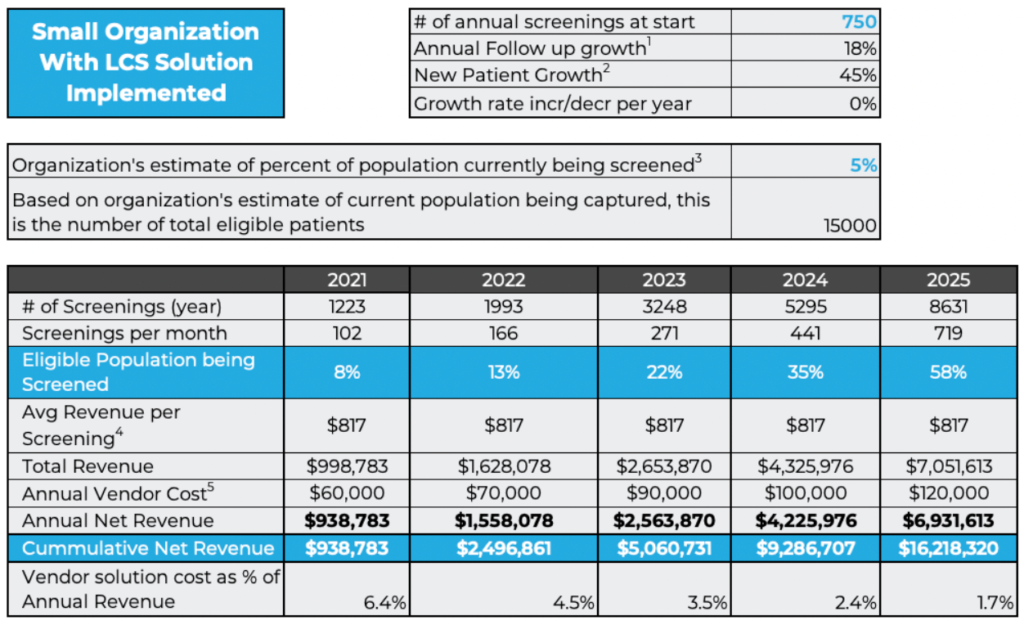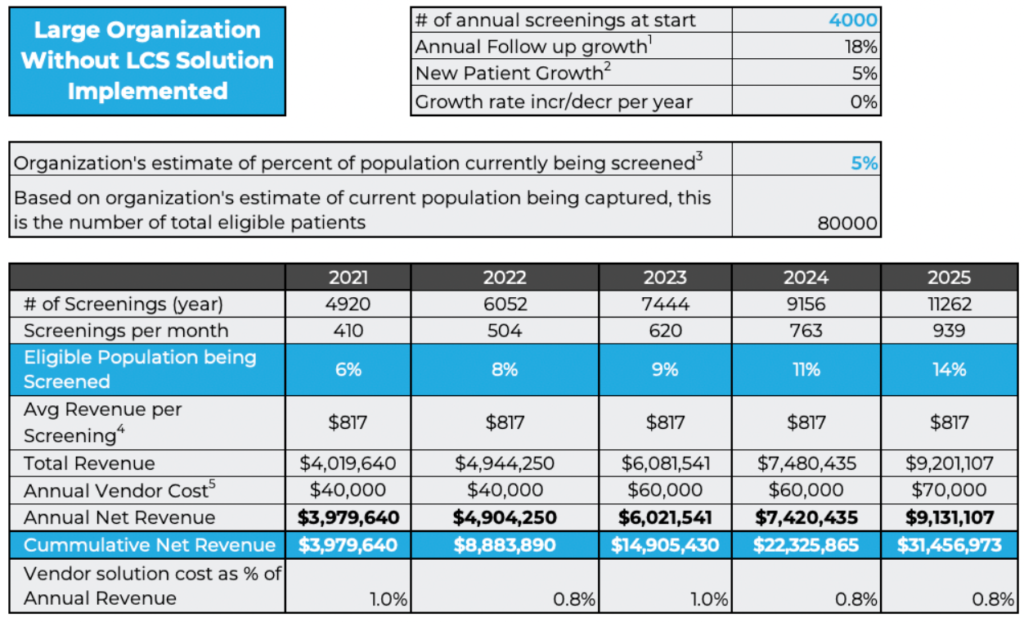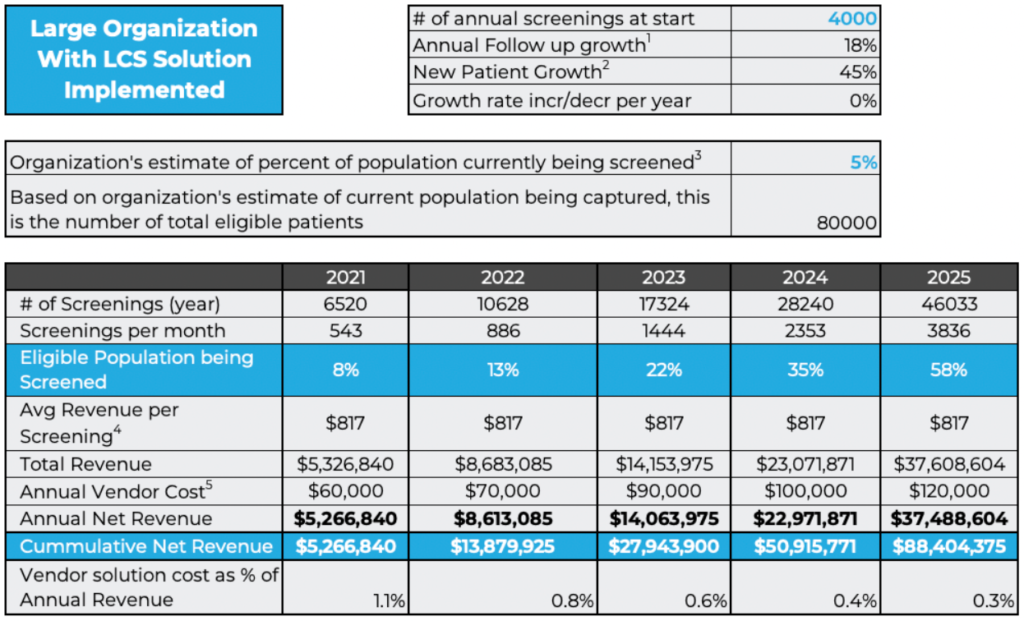LCS Program - ROI & Total Capture of Eligible Patients
Manual LCS Solution vs Thynk Health’s Automated LCS Solution

The State of Lung Cancer Research
Currently, 1 in 15 people in the U.S. can expect to receive a lung cancer diagnosis. Lung cancer kills almost twice as many women as breast cancer, and more than three times as many men as prostate cancer(1). In 2019, 142,670 Americans died of lung cancer – more than the next three cancers combined(2). Unfortunately, federal funding for lung cancer research per related death was just $1,680 compared to $24,846 for breast cancer, $12,644 for prostate cancer, and $6,344 for colon cancer in 2018(1).
Despite the fact that 65% of new lung cancer cases are found in former smokers and those who have never smoked and approximately 7,330 lung cancer deaths are due to secondhand smoke exposure, there is still a strong stigma associated with lung cancer(1). This stigma has led to a notable inequality in federal funding for lung cancer research. Lung cancer is often viewed as a self-inflicted disease and is thus deemed less deserving of funding(3).
With a 19% five-year survival rate, lung cancer ranks the lowest among the other most common cancers: prostate cancer (99%), breast cancer (89%), and colorectal cancer (65%). Fewer than 1 in 7 lung cancer patients will be diagnosed in the earliest stage, when the disease is most treatable. If lung cancer is caught before it spreads, the likelihood of surviving five years or more improves to 55%. Early detection through low-dose CT screening can decrease lung cancer mortality rates by 14%-20% among high-risk populations(1).
Opportunity for Growth: Lung Cancer Screening
With new recommendations for screening, an estimated 15 million Americans are now eligible for lung cancer screening, doubling the current number(8). Yet according to a new report by the American Lung Association (ALA), only 5.7% of people who are high-risk for developing the disease are actually undergoing screening. This low rate of uptake may be due in part to the stigma attached to lung cancer and the consequential lack of substantial funding(7). This is an extremely low rate of screening, especially when compared to the screening rates of the next three cancers which have no attached stigmas. In 2018, the total capture of eligible patients for cancer screening was measured at 68.8% for colorectal cancer(4), 66.7% for breast cancer(5), and 39% for prostate cancer(6). It is time to lose the stigma with lung cancer and bring the screening rate to levels similar to those of other lethal cancers.
Attaining the average screening rate near the next three cancers at 58.2% over the next 5 years is a very achievable goal with the right leadership, tools and effort. Under the Affordable Care Act, private insurers must cover services, without patient cost-sharing, that receive “A” or “B” recommendations from the USPSTF(8). With a change in the stigma associated with lung cancer along with the implementation of an advanced lung cancer screening solution, organizations can realize screening rates that approach 50% within the first 5 years of implementation, saving millions of lives each year and producing significant revenue in the process.
In order to drastically alter these statistics, organizations must take action and implement an advanced lung cancer screening solution that has the essential components for rapid growth. The LCS solution should capture required data, increase the efficiency of staff,and ensure that patients do not slip through the cracks of complex screening and care delivery programs. With the new guidelines of lowering the screening age and smoking rates, it is essential to take action soon to prepare for the nearly doubling of eligible patients in the near future. The goal should be creating healthier communities by achieving higher screening rates within the next 5 years.
ROI of Manual vs Automated LCS Solutions
In the examples below, we illustrate the comparison of two LCS programs. The first, the most common situation, is a site using spreadsheets, a homegrown database, paper or a rudimentary application from the EMR vendor that requires a great deal of manual input. Without a significant increase to staffing, this scenario will achieve screening rates around 15% at the end of 5 years. The second is a site using an advanced LCS solution that captures the required data from the natural work effort of the radiologists and the EMR database as well as automating functions like mailings for results, follow up exams and other tasks, allowing the navigator to be significantly more productive. These sites will be able to get to 50% of eligible patients at the end of 5 years.
Example 1A – Individual Hospital with basic LCS Program

Example 2A-Individual Hospital with Advanced LCS Program

Example 1B – Large Health System with Basic LCS Program

Example 2B -Large Health System with Advanced LCS Program

Assumptions as notated in examples above :
- 1 – Annual follow up growth – this represents 90% of previous year returning
- 2 – New patient growth – this represents growth from new patients only
- 3 – Organization estimate of current screening % – national average is 4%-6%
- 4 – Average revenue per screening – taken from Cleveland Clinic Study
- 5 – Annual vendor cost – based on national averages of many vendors
About Thynk Health
Thynk Health is designed for organizations looking to enable the rapid growth needed to meet the screening average of the next three cancers (colon, breast, prostate) at 58.2% over the next 5 years. In order for a LCS program to achieve this goal, their solution requires the following attributes, which Thynk Health demonstrates:
- Accurate – Number 1 in accuracy achieved with groundbreaking AI 2.0 and deep learning that captures the natural workflow of clinician and radiologist reporting
- Automated – Advanced automation requires less resources while driving more efficiency. Staff transitions from data entry clerks to focus on patient care
- Simplified – Dashboards are created with nurse navigator input to provide the required data for quick, accurate and decisive action
- Powerful – Actionable intelligence that improves screening, tracking, and incidental finding management
- Secure – Not off-shored or outsourced, a solution developed (and serviced) in the USA that you know you can trust
- Quality Assurance – Mitigate risks with automated communications and management of incidental findings
In addition to meeting these basic requirements for a LCS solution, Thynk Health’s Lung Module goes a step further and offers the following additional features:
- Thynk Health’s solution is configurable to adapt to the clinical workflow of your LCS program, while others offer a one-size-fits-all solution that requires you to adapt to their workflow.
- Thynk Health is designed for scale to handle the high-volume growth of lung screening programs with reduced need for additional staffing. Their goal is to give caregivers the ability to focus on patient care as the program expands and not, as others advocate, to eliminate jobs.
- Thynk Health eliminates manual mailing tasks of the nurse navigator by automatically sending reminder and results letters to patients and/or providers. We are the only solution that doesn’t require the navigator to download each letter, print it off, manually stuff envelopes or send.
- Thynk Health leverages Machine Learning and AI to provide advanced analytics reporting enabling targeted campaigns for specific regions and groups based on actionable data. The robust data and user friendly presentation ensures equitable treatment for patients, growth in volume, improved time from diagnosis to treatment and stage shifting of cancer patients to Stage 1 and 2 cancers for increased survivability for the identified patients.
- Thynk Health was founded by radiologists with a vision to extract all clinically important findings from any organ and all radiology reports.
- Thynk Health’s solution automates manual processes, enabling radiologists to perform their natural act of dictating their report, allowing Thynk Health to identify key medical data, extract it and place it in the required fields so the nurse navigator can efficiently and effectively care for the patients. The identification and creation of data needs to be done with minimal change in the workflow of the radiologist and clinical staff. Without this, the compliance of radiologists and others falls below 100%. The times when the altered workflow isn’t followed, it adds more work for the navigator to find, input and augment data, reducing efficiency and accuracy of the program. Any solution that makes clinicians change their workflow reduces accuracy and adds more work while decreasing possible growth. When you implement a solution like Thynk Health, maximizing workflow with great data, the nurse navigators can educate, recruit, and perform other tasks to improve the program.
Partnering with Thynk Health can put your organization in the right position for the rapid growth required to address the low screening rate for lung cancer and improve revenue as the volume and efficiencies increase. It is time to improve lung cancer screening rates before the new guidelines come into effect. Schedule a demo with Thynk Health today to learn more about how we can transform your lung cancer screening program.
References
(1) https://lcfamerica.org/lung-cancer-info/lung-cancer-facts/#1548796105763-eb87ec3a-6bfc
(4) https://www.cdc.gov/cancer/colorectal/statistics/index.htm
(5) https://www.cdc.gov/nchs/fastats/mammography.html
(6) https://progressreport.cancer.gov/detection/prostate_cancer
(7) https://www.tandfonline.com/doi/full/10.1080/17476348.2018.1428564
(8) https://www.washingtonpost.com/health/2021/03/09/lung-cancer-screening/
